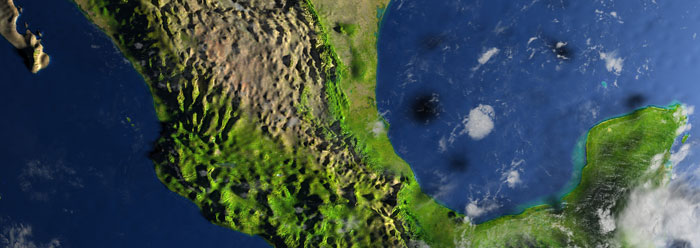In secular literature and movies, the most popular explanation for the dinosaurs’ extinction is an asteroid impact. The Chicxulub crater in Mexico is often referred to as the “smoking gun” for this idea. But do the data support an asteroid impact at Chicxulub? I recently reviewed the evidence and found some surprising results.1
The Chicxulub crater isn’t visible on the surface because it is covered by younger, relatively undeformed sediments. It was identified from a nearly circular gravity anomaly along the northwestern edge of the Yucatán Peninsula (Figure 1).2,3 There’s disagreement on the crater’s exact size, but its diameter is approximately 110 miles—large enough for a six-mile-wide asteroid or meteorite to have caused it.
Although some of the expected criteria for identifying a meteorite impact are present at the Chicxulub site—such as high-pressure and deformed minerals—not enough of these materials have been found to justify a large impact.1 And even these minerals can be caused by other circumstances, including rapid crystallization4 and volcanic activity.5
The biggest problem is what is missing. Iridium, a chemical element more abundant in meteorites than on Earth, is a primary marker of an impact event. A few traces were identified in the cores of two drilled wells, but no significant amounts have been found in any of the ejecta material across the Chicxulub site.6 The presence of an iridium-rich layer is often used to identify the K-Pg (Cretaceous-Paleogene) boundary, yet ironically there is virtually no iridium in the ejecta material at the very site claimed to be the “smoking gun”!
In addition, secular models suggest melt-rich layers resulting from the impact should have exceeded a mile or two in thickness beneath the central portion of the Chicxulub crater.7 However, the oil wells and cores drilled at the site don’t support this. The thickest melt-rich layers encountered in the wells were between 330 and 990 feet—nowhere near the expected thicknesses of 5,000 to 10,000 feet—and several of the melt-rich layers were much thinner than 300 feet or were nonexistent.
Finally, the latest research even indicates that the tsunami waves claimed to have been generated by the impact across the Gulf of Mexico seem unlikely.8
The thinner-than-expected melt-rich layers, the lack of any substantial iridium anomaly, and the alternative explanations for the high-pressure and deformed minerals and the gravity anomaly1 all raise concerns about the Chicxulub crater and ultimately the asteroid extinction theory itself. An impact may have occurred at Chicxulub during the Flood, but if so, it seems to have been much smaller than commonly claimed, creating a mere fraction of the postulated effects. And it’s entirely possible there was never an impact at Chicxulub in the first place. All of the data can have non-impact explanations.1
The Chicxulub impact has become the iconic tale most secular scientists use for the so-called major extinction event that wiped out the dinosaurs.9 They need such a story because they categorically reject Earth history as described in the Bible, including the global Flood. In order to explain the disappearance of the dinosaurs and other creatures, they uphold the Chicxulub impact as one of the principle factors in their tale—even though the evidence for the impact at the Chicxulub site is not nearly as strong as they claim.
After careful examination of the data, the smoking gun appears to be mostly smoke.
References
- Clarey, T. L. 2017. Do the Data Support a Large Meteorite Impact at Chicxulub? Answers Research Journal. 10: 71-88.
- Penfield, G. T. and Z. A. Camargo. 1981. Definition of a major igneous zone in the central Yucatán platform with aeromagnetics and gravity. In Technical Program, Abstracts and Bibliographies. Tulsa, OK: Society of Exploration Geophysicists, 51st Annual Meeting, 37.
- Hildebrand, A. R. et al. 1991. Chicxulub Crater: A possible Cretaceous/Tertiary boundary impact crater on the Yucatán Peninsula, Mexico. Geology. 19 (9): 867-871.
- Huffman, A. R. and W. U. Reimold. 1996. Experimental constraints on shock-induced microstructures in naturally deformed silicates. Tectonophysics. 256 (1-4): 165-217.
- Alexopoulos, J. S., R. A. F. Grieve, and P. B. Robertson. 1988. Microscopic lamellar deformation features in quartz: Discriminative characteristics of shock-generated varieties. Geology. 16 (9): 796-799.
- Keller, G. et al. 2004. More evidence that the Chicxulub impact predates the K/T mass extinction. Meteoritics & Planetary Science. 39 (7): 1127-1144.
- Morgan, J. V. et al. 2000. Peak-ring formation in large impact craters: geophysical constraints from Chicxulub. Earth and Planetary Science Letters. 183 (3-4): 347-354.
- Boslough, M. et al. Asteroid-Generated Tsunami and Impact Risk. Abstract NH13A-1763. 2016 American Geophysical Union Fall Meeting, San Francisco.
- A limited number of dinosaur bones have been found above the K-Pg boundary in several locations across the earth. However, most secular scientists think these bones were merely “reworked” by erosion from earlier bone deposits.
* Dr. Clarey is Research Associate at the Institute for Creation Research and earned his Ph.D. in geology from Western Michigan University.




